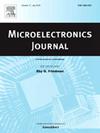A 2–36 GHz CMOS LNA with π-Network-Based wideband interstage matching technique for software-defined radio systems
IF 1.9
3区 工程技术
Q3 ENGINEERING, ELECTRICAL & ELECTRONIC
引用次数: 0
Abstract
With the advance in wireless communication, next-generation software-defined radio (SDR) systems require transceivers to operate in both sub-6GHz and millimeter-wave (mmWave) band and support multiple standards. However, bridging sub-6GHz frequencies with millimeter-wave bands exceeding 30 GHz remains a challenge for conventional wideband LNAs. To surmount this, a 2–36 GHz CMOS low-noise amplifier (LNA) designed for SDR systems is introduced in this paper. An innovative wideband input matching network capable of spanning both frequency domains is proposed. The methodology effectively mitigates the impact of vast parasitic capacitances, achieving wideband input matching against Electrostatic Discharge (ESD) and on-chip decoupling capacitor parasitic. In addition, a π-network-based wideband interstage matching technique is adopted to extend bandwidth of gain. A tri-stage prototype of the proposed LNA, designed using a 40-nm CMOS process, is designed to validate our design strategies. The post-simulation outcomes reveal a peak gain of 14 dB with a -3dB bandwidth ranging from 2 to 36 GHz, equating to a fractional bandwidth of 178 %. The Noise Figure (NF) is commendably uniform across the frequency spectrum, stabilizing at 5 dB. Furthermore, the third-order input intercept point (IIP3) is −4.2dBm to -3dBm across the bandwidth. The performance is achieved with a power of 19.4 mW and within a core area of 0.1 mm2.
用于软件定义无线电系统的 2-36 GHz CMOS LNA,采用基于 π 网络的宽带级间匹配技术
随着无线通信技术的发展,下一代软件定义无线电(SDR)系统要求收发器同时工作在 6GHz 以下和毫米波(mmWave)频段,并支持多种标准。然而,对于传统的宽带 LNA 而言,在 6GHz 以下频率与超过 30 GHz 的毫米波频段之间架起桥梁仍然是一项挑战。为了克服这一难题,本文介绍了一种专为 SDR 系统设计的 2-36 GHz CMOS 低噪声放大器(LNA)。本文提出了一种能够跨越两个频域的创新型宽带输入匹配网络。该方法可有效减轻巨大寄生电容的影响,实现针对静电放电(ESD)和片上去耦电容寄生的宽带输入匹配。此外,还采用了基于 π 网络的宽带级间匹配技术来扩展增益带宽。为了验证我们的设计策略,我们设计了一个采用 40 纳米 CMOS 工艺设计的三级 LNA 原型。模拟后的结果显示,峰值增益为 14 dB,-3dB 带宽为 2 至 36 GHz,相当于 178 % 的分数带宽。噪声系数(NF)在整个频谱范围内非常均匀,稳定在 5 dB。此外,三阶输入截取点 (IIP3) 在整个带宽范围内为 -4.2dBm 至 -3dBm。实现这一性能的功率为 19.4 mW,核心面积为 0.1 mm2。
本文章由计算机程序翻译,如有差异,请以英文原文为准。
求助全文
约1分钟内获得全文
求助全文
来源期刊

Microelectronics Journal
工程技术-工程:电子与电气
CiteScore
4.00
自引率
27.30%
发文量
222
审稿时长
43 days
期刊介绍:
Published since 1969, the Microelectronics Journal is an international forum for the dissemination of research and applications of microelectronic systems, circuits, and emerging technologies. Papers published in the Microelectronics Journal have undergone peer review to ensure originality, relevance, and timeliness. The journal thus provides a worldwide, regular, and comprehensive update on microelectronic circuits and systems.
The Microelectronics Journal invites papers describing significant research and applications in all of the areas listed below. Comprehensive review/survey papers covering recent developments will also be considered. The Microelectronics Journal covers circuits and systems. This topic includes but is not limited to: Analog, digital, mixed, and RF circuits and related design methodologies; Logic, architectural, and system level synthesis; Testing, design for testability, built-in self-test; Area, power, and thermal analysis and design; Mixed-domain simulation and design; Embedded systems; Non-von Neumann computing and related technologies and circuits; Design and test of high complexity systems integration; SoC, NoC, SIP, and NIP design and test; 3-D integration design and analysis; Emerging device technologies and circuits, such as FinFETs, SETs, spintronics, SFQ, MTJ, etc.
Application aspects such as signal and image processing including circuits for cryptography, sensors, and actuators including sensor networks, reliability and quality issues, and economic models are also welcome.
 求助内容:
求助内容: 应助结果提醒方式:
应助结果提醒方式:


